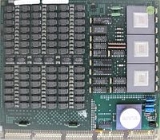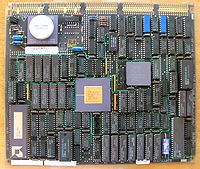
VAXBI Bus
Encyclopedia

Computer
A computer is a programmable machine designed to sequentially and automatically carry out a sequence of arithmetic or logical operations. The particular sequence of operations can be changed readily, allowing the computer to solve more than one kind of problem...
bus designed and sold by the Digital Equipment Corporation
Digital Equipment Corporation
Digital Equipment Corporation was a major American company in the computer industry and a leading vendor of computer systems, software and peripherals from the 1960s to the 1990s...
(DEC) of Maynard, Massachusetts
Maynard, Massachusetts
Maynard is a town in Middlesex County, Massachusetts, United States. As of the 2010 census, the town population was 10,106.- History :Maynard, located on the Assabet River, was incorporated as an independent municipality in 1871. Prior to that it was known as 'Assabet Village' but was legally...
.

VAX
VAX was an instruction set architecture developed by Digital Equipment Corporation in the mid-1970s. A 32-bit complex instruction set computer ISA, it was designed to extend or replace DEC's various Programmed Data Processor ISAs...
computers. Like the Unibus
Unibus
The Unibus was the earliest of several computer bus technologies used with PDP-11 and early VAX systems manufactured by the Digital Equipment Corporation of Maynard, Massachusetts.-History:...
and Q-Bus
Q-Bus
The Q-bus was one of several bus technologies used with PDP and MicroVAX computer systems manufactured by the Digital Equipment Corporation of Maynard, Massachusetts....
before it, it used memory-mapped I/O
Memory-mapped I/O
Memory-mapped I/O and port I/O are two complementary methods of performing input/output between the CPU and peripheral devices in a computer...
but had 32-bit address and data paths. The VAXBI was a multiplexed bus with fully distributed arbitration and geographic addressing.
All of the logic required to implement a VAXBI interface was contained within a single custom integrated circuit (the "BIIC") and the physical layout and printed wiring board layup for compliant cards was tightly specified, right down to the location of the dual amber status LED
LEd
LEd is a TeX/LaTeX editing software working under Microsoft Windows. It is a freeware product....
s that were required. The portion of the card that was reserved for the bus interface was referred to as "the VAXBI corner". VAXBI licensees were given the appropriate engineering drawings to allow them to exactly replicate a compliant card.
VAXBI cards mounted into backplanes using a ZIF connector; depending on the backplane design, cards could be loaded from the top or the front side of the backplane. No cable connections were permitted on the cards; all connections were made via three uncommitted rows of backplane connectors. Similarly, no configuration jumpers were permitted on the cards; all setup was done by jumpers inserted on the backplane connectors or via software configuration.
Originally conceived by its engineers to be an open bus, it was forced to be a tightly licensed bus by Digital's marketing and management, and was not nearly as successful as had originally been hoped-for.
It was used in the VAX 6000
VAX 6000
The VAX 6000 was a family of minicomputers developed and manufactured by Digital Equipment Corporation using processors implementing the VAX instruction set architecture...
, VAX 8000
VAX 8000
The VAX 8000 was a family of minicomputers developed and manufactured by Digital Equipment Corporation using processors implementing the VAX instruction set architecture .- VAX 8600 :...
(82xx, 83xx, 85xx, 87xx, 88xx models) and the VAX 9000
VAX 9000
The VAX 9000, code named Aridus, was a family of high-end minicomputers developed and manufactured by Digital Equipment Corporation using processors implementing the VAX instruction set architecture . The VAX 9000 was positioned by Digital as its first mainframe...
systems.
A PDP-11
PDP-11
The PDP-11 was a series of 16-bit minicomputers sold by Digital Equipment Corporation from 1970 into the 1990s, one of a succession of products in the PDP series. The PDP-11 replaced the PDP-8 in many real-time applications, although both product lines lived in parallel for more than 10 years...
implementation (the PDP-11/27) was also envisioned but never advanced beyond the concept stage.

